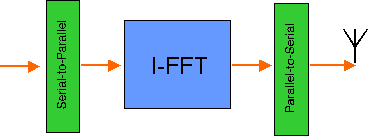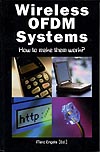|
OFDM Transmitter based on I-FFT |
||
|
In an OFDM transmitter, blocks of k incoming bits are encoded into n channel symbols. Before transmission, an n-point Inverse-FFT operation is performed. When the signals at the I-FFT output are transmitted sequentially, each of the n channel symbols appears at a different (subcarrier) frequency. Such coding across subcarriers is necessary. If one subcarrier experiences deep fading, this leads to erasure of the data symbol on this subcarrier. |

 IMEC
in Leuven Belgium developed efficient implementations for OFDM WLANs (see
Book by Marc Engels et al. with Kluwer: "Wireless OFDM Systems, How to
make them work,"
IMEC
in Leuven Belgium developed efficient implementations for OFDM WLANs (see
Book by Marc Engels et al. with Kluwer: "Wireless OFDM Systems, How to
make them work,"